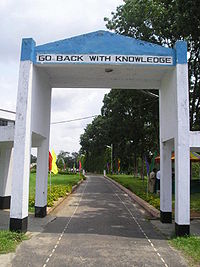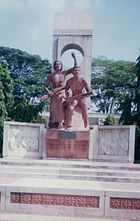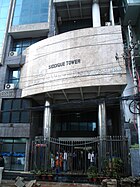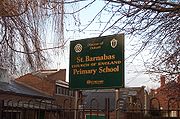From Wikipedia, the free encyclopedia
Jump to: navigation, search
| Rajshahi University |
| ??????? ???????? 09;????? |
|
|
| Established |
1953 |
| Type: |
Public |
| Chancellor: |
Iajuddin Ahmed |
| Vice-Chancellor: |
M Altaf Hossain |
| Faculty: |
1000 |
| Staff: |
2000 |
| Students: |
25000 |
| Location: |
Rajshahi, Bangladesh |
| Campus: |
Urban, 753 acres (3 km) |
| Website: |
www.ru.ac.bd |
Rajshahi University or University of Rajshahi (Bengali: ??????? ???????? 09;????? , Rajshahi Bishshobiddale) is a public university located in Rajshahi, a city in northern Bangladesh. Rajshahi University was established in 1953, the second university to be established in what was then East Pakistan.
The university's forty-seven departments are organised into eight faculties. Rajshahi University is located in a 753 acres (3 km) campus in Motihar, 3 kilometres (2 mi) from the Rajshahi city center. With 25,000 students and close to 1000 academic staff, it is one of the largest universities in Bangladesh.[1] In addition to hosting programs in the arts, sciences, Agriculture, social sciences, business studies and medical sciences, the university houses a number of institutes of higher studies.
|
Contents[]
1 History
2 Campus
2.1 Main campus
2.2 Other facilities
- 2.3 Art and architecture
3 Organisation and administration
4 Academics
4.1 Faculties
4.2 Education and research
- 4.3 Institutes, library and press
5 Student life
5.1 Housing
- 5.2 Activities
6 Alumni and notable staff
7 Criticism and controversy
8 Notes
9 References
- 10 External links
|
type=text/javascript>
//
[edit] History
Juberi Guest house is named after the university's first vice-chancellor

A list of the martyrs of Rajshahi University during the Liberation war.
The first proposal to establish a university came in 1917, when Calcutta University created the Sadler Commission[2] to assess the university system in Bengal. However, the recommendations of the report had no immediate consequences.
Following the Partition of India in 1947, what is now Bangladesh became East Pakistan. University of Dhaka, established in 1926, was the only university in East Pakistan at the time. Demand for a university in the northern part of East Pakistan gained momentum when two universities were established in West Pakistan without the establishment of any in the east. Students of Rajshahi College were at the forefront of the movement demanding a new university.[3] Finally, Rajshahi was selected as the home for the second university in East Pakistan and the Rajshahi University Act of 1953 (East Bengal Act XV of 1953) was passed by the East Pakistan provincial Assembly on 31 March 1953.[4] Itrat Hossain Juberi, the Principal of Rajshahi College was appointed the first vice-chancellor of the university. Initially, the university was housed in temporary locations, such as the local circuit house and Bara Kuthi, a 18th-century Dutch establishment. B B Hindu Academy, a local school, housed the library, teachers' lounge and the medical centre of the university. The university started out with 20 professors, 161 students (of which 5 were female) and six departments—Bengali, English, History, Law, Philosophy and Economics. In 1964, the offices moved to the permanent campus.
The 1960s was a turbulent period in the history of Bangladesh, when demands for East Pakistani autonomy became stronger. The students and staff of the university started playing an increasing role in politics during this period. On 18 February 1969, Shamsuzzoha, a professor of the university was killed by the police when he tried to prevent them from shooting student demonstrators.[5] This date is now commemorated as Zoha Day.[6] During the Bangladesh Liberation War of 1971, the university campus was used as a base by the Pakistan Army. A number of professors, students and officers of the university were killed by the Pakistan army during this period.
After independence, a new act regarding the administration of the university came into being—the Rajshahi University Act of 1973. The current emblem of the university was also selected. The circle of the emblem represents the world. A open book is shown in red and gold, red representing one of the colors of the national flag, and gold the value of education. The body of the book is blue, the color of the sky, and at the centre is a shapla flower (Nymphaeaceae), the national flower of Bangladesh. The post-liberation years saw the university grow steadily in student enrollment and size of the academic staff. However, the 1980s were turbulent years for the university, as the students agitated with other institutions of the country against the military rule of Hossain Muhammad Ershad. Since early 1990s, the university have seen relative calm and lowering of session backlogs, though active student politics remains a contentious issue to date.
[edit] Campus
[edit] Main campus
Krishnachura blossoms in front of the First Science building, that houses Physics and Computer science

Shabash Bangladesh commemorates the Bangladesh Liberation War
The university's main campus is located in Motihar, on the eastern side of the city of Rajshahi and a mile from the river Padma.[4] The campus area is nearly 753 acres (3.05 km). Access to the walled-off university campus is controlled through three security gates. The campus houses eleven large academic buildings—five for the arts, business studies and social sciences, four for the sciences and two for agricultural studies.
The central part of the university, accessible by the main gate, is dominated by the administrative building, where the offices of the Vice-Chancellor and other officials are located. This is flanked by the senate building and the residence of the Vice-Chancellor on one side (also featuring the famous Shabash Bangladesh sculpture) and the university mosque and martyr monument complex on the other.[7] Behind the administrative building is the central library, around which the four science buildings and three main arts buildings are located. The science buildings are named numerically as the "First Science Building" and so on. The arts buildings are named respectively after Muhammad Shahidullah, Momtazuddin Ahmed and Rabindranath Tagore. More towards the east lie the stadium, the new teacher-student centre and the main auditorium.
The Kazla gate provides access to the south-western part of the campus. The Juberi international guest-house, Rajshahi University School and the main residential facilities for the academic staff and university officers are located here.[7] Near the residential areas are all five dorms (known as residential halls) for female students. The eastern part of the campus houses the Institute of Bangladesh Studies,[8] the medical and sports facilities and more residential facilities for the university staff—but is dominated by the eleven large dormitories for male students. From the Binodpur gate, the residential halls named after Nawab Abdul Latif, Shamsuzzoha and Madarbux are located to the north, while the oldest dorms Motihar Hall and Sher-e-Bangla hall lie to the west. One of the largest mass graves in Bangladesh from the liberation war era is located behind Shamsuzzoha Hall.[9]
The campus contains a quite a few mango orchards. The Rajshahi area is generally well-known for producing the best mangoes in the country,[10] and these orchards are leased out to professional farmers during the summer, when the fruits grow. The campus also reflects the region's silk industry, fields of mulberry trees are to be seen in the campus, both for agricultural and research needs. The northern part of the campus houses a botanical garden, which has a good collection of rare plants.
[edit] Other facilities

The martyr monument is perhaps the most well known landmark in the University
A few miles from the main campus is the Varendra Research Museum, home to one of the foremost collections on history and archaeology of Bengal in the world.[11] Established in 1910 by Ramaprasad Chanda, the museum became a part of the university in 1960s when a financial crisis threatened its existence. Under the university, the museum has thrived, adding an folklore gallery to its impressive collection from ancient and medieval Bengal. The Bara Kuthi, where the university was established is also still under university control, and is located on the Padma not too far away from Varendra Museum. The university has an agricultural facility few miles from the main campus. Rajshahi University maintains other facilities across the country including a guesthouse in the capital city, Dhaka.
[edit] Art and architecture
Rajshahi University is home to many architectural and artistic landmarks. The Martyr's Monument is an important example, complete with a mural designed by Murtaza Bashir. The Senate House is a modern mini-parliament house, usually used for meetings of the senate of the university, but it also accommodates national and international conferences, seminars and symposia. In front of the Senate House is Shabash Bangladesh, the largest war memorial sculpture in the nation; it was designed and constructed by Nitun Kundu.[12] The name comes from a poem by Sukanta Bhattacharya of the same name, the last four lines of which is engraved under the structure. Golden Jubilee Tower, a 2003 addition to the university's array of sculptures, commemorates the university's 50th anniversary.[13] Other well-known buildings include the library and the university mosque. The Department of Fine Arts hosts a sizeable collection of contemporary art, while Varendra Museum has a large collection of ancient and medieval art.
[edit] Organisation and administration
The university is run according to the Rajshahi University Act of 1973.[14] The act, passed in 1973, allows the university considerably more autonomy than most other peer institutions. The president of Bangladesh is the de-facto Chancellor of the university, but his role is mainly ceremonial. The highest official after the Chancellor is the Vice-Chancellor, selected by the senate of the university every four years. The Vice-Chancellor, as of 2007, is M Altaf Hossain. Other important officers of the university include the Pro-Vice-Chancellor, the registrar, the controller of examinations and the proctor.[14] The proctor is in direct charge of student activities and is the official with most direct contact with the students. The most important statutory bodies of the university are the senate, the academic council and the syndicate.[14] As a public institution, most of Rajshahi University's funding comes from the government. The University Grants Commission (UGC) is the body responsible for allocating funds to all public universities. In the 2005–06 fiscal year, the UGC granted 59 crore taka (around US$10 million) to the university; the university was expected to raise another 3 crore taka from its internal resources.[4]
Students are admitted after they pass the Higher Secondary Exam (HSC exam). Students partake in entrance examinations, a separate one for each department.[15] This has been a contentious issue,[16] as there used to be only one exam for each faculty, after which students would be allocated to departments according to their result and choice of program. As a public university, Rajshahi University's tuition fees are relatively low; nevertheless, a hike in admission fees, during the 2006–07 session, have drawn criticism from student bodies.[17] As of 2007, the university awards a total of 340 scholarships, whose annual value is around 1.1 million taka. In addition, there are merit awards given by residential halls, departments and the university itself. Students are also eligible for the Prime Minister's Gold Medal award.[18] All colleges of the northern and southern regions of the country used to be affiliated with Rajshahi University. However, the administration of colleges across the country was taken over by the National University when it was established in 1992.[19]
[edit] Academics
[edit] Faculties
|
Faculties of the university
Faculty of Arts
Faculty of Social Sciences
Faculty of Science
Faculty of Law
Faculty of Medicine
Faculty of Life and Earth Science
Faculty of Agriculture
- Faculty of Business Studies
|
The university's 47 departments are organised into eight faculties: Arts, Law, Science, Medicine, Business Studies, Social Sciences, Life and Earth Sciences, and Agriculture.[20] The Arts and the Law faculties are the oldest in the university, both established in 1953, closely followed by the Faculty of Science (1956). The university's departments represent the traditional studies in arts and sciences through programs in history, linguistics, economics, mathematics, physics etc, but is increasingly emphasizing on more specialised programs such as information and communication engineering (est 2000) or genetics and breeding (est 1996).[3]
The Faculty of Arts includes departments in languages and linguistics (Bengali, English, Arabic), historical studies (history, Islamic history and culture), philosophy and fine arts. In the late 1990s, programs in theater, music and folklore studies were introduced. The Faculty of Social Science has programs in sociology, social work, anthropology, economics, political science and media-related studies.[21] The Faculty of Law consists only of the department of law, while the departments of finance & banking, management, marketing and accounting make up the Faculty of Business Studies. All facilities of these three faculties are located in the three arts buildings. The four science buildings house the Faculty of Science and the Faculty of Life and Earth Science. The former has programs in physics, applied physics, mathematics, computer science, chemistry, biochemistry and information technology.[21] Prominent departments in the faculty of Life and Earth Sciences include zoology, botany and geography; these are all housed in the third science building.

Momtazuddin Arts Building houses some departments of the Faculty of Arts
Founded in 2000, the Faculty of Agricultural is the newest addition to the university, and was formed when a local agricultural college was absorbed into the university. The Faculty has programs in fishery, genetic engineering, agronomy and veterinary sciences.[21]
Faculty of medicine is organised differently from other disciplines. Medical education is provided by seven medical colleges located around the Rajshahi division. Though these colleges are autonomous to a large extent, the degrees are conferred by Rajshahi University. Rajshahi Medical College is the oldest medical college under administration of the university and is located a few miles west of the university campus. The university used to have an engineering program through BIT (Bangladesh Institute of Technology) Rajshahi, but BIT became an independent university and was renamed Rajshahi University of Engineering and Technology in 2002.
[edit] Education and research

The administrative building dominates the main entrance to the university
Undergraduates enroll for a four-year program. Students are assigned to a major when they enter the university, and cannot change it later. Science and business disciplines are in high demand, as these fields are perceived to have better job opportunities. Most programs are organised by years, though the business programs use a semester system, and others have been following suit.[3] Classes can be quite large in departments like history or accounting, due to a high student-to-teacher ratio.
Most departments offer masters programs that are one or two years in duration. Admission to the masters program for graduates of the university is virtually guaranteed. Research in the university is conducted in specialised institutes as well as individual departments, which all have doctoral programs. As in other universities across the country, research plays second fiddle to education. Nevertheless, the university has a strong research program related to the arsenic problem in Bangladesh.[22] The Institute of Bangladesh Studies is a noted research institute that publishes the Journal of IBS, a well-regarded research publication. The university is also home to Centre for Social Science Research (CSSR), an independent organisation conducting empirical and qualitative research in many fields.[23] Much research work also centres around Varendra Research Museum.[11]
[edit] Institutes, library and press
The university is home to five institutes. The oldest, established in 1974, is the Institute of Bangladesh Studies (IBS). Housed in the eastern end of the main campus, IBS was established by the Parliament of Bangladesh for research in Bangladesh-related topics. The institute conducts research and education at the postgraduate level, and has awarded 153 PhD degrees and 71 MPhil degrees in the humanities, social sciences and non-experimental sciences to date. The Institute of Biological Sciences (established in 1989) is another research institute focused on genetics and biological sciences, and was established through collaboration with the National Planning Commission.[24] Three newer institutes have been established since: the Institute of Business Administration, the Institute of Environmental Sciences and the Institute of Education and Research. As of 2006, the establishment of two more institutes, an Institute of English Language and a post-graduate Institute of Information Technology was under way.[3] The latter was established during a drive by the Bangladesh government to promote education in Information Technology, when it provided Rajshahi University and 4 other major universities 3 crore taka each towards establishment of an IT institute.
The central library was established in 1955. Initially located at Bara Kuthi it was later shifted to its present location in the centre of the university campus. The library has a collection of 300,000 books and 2,000 journal titles.[3] Students are found studying both in the reading rooms of the library and on the spacious corridors encircling the library on the ground floor.[25] In addition to the central library, there are seminar libraries in all institutes, departments and residential halls. Rajshahi University Press publishes scholarly books on many topics, mostly written by the members of the university teaching staff.
[edit] Student life
[edit] Housing

Varendra Museum is the oldest in the nation and an important resource for the university
The university has sixteen residential halls for students, five for women and eleven for men. The residential halls are named after prominent Bangladeshi historical and cultural figures, some of them from Rajshahi. The largest men's hall is Shahid Habibur Rahman Hall, named after a mathematics professor killed on campus during the 1971 war by the Pakistani Army. The largest women's hall is Monnujan Hall,[26] followed by Begum Rokeya Hall, named after Rokeya Sakhawat Hussain, a leading figure in women's rights activism in Bengal. The housing system can accommodate 8,000 students, which has created a deepening accommodation crisis as the student body has risen to 25,000.[26] Apart from the seat limitations, the amenities of these halls do not always meet decent accommodation standards.[27] This has led to the establishment of many privately owned off-campus "messes". The residential halls provide meals, which are subsidised by the university authorities.
[edit] Activities
The physical education department of the university has 27 instructors, a 25,000-seat stadium, 2 gymnasiums, 1 swimming pool, 4 football grounds, 1 hockey ground, 4 tennis courts, 2 basketball courts and a squash court. Rajshahi University is considered a leader in university sports in the nation, boasting impressive facilities and winning many inter-university sports events.[3] The Teacher-Student Cultural Centre was designed to be the centre of cultural activities of the university. The university auditorium, the RUCSU building and the individual residential halls also are centres for cultural activities. The university is home to recitation groups like Shwanan, and drama groups like Anushilon and Rajshahi University Drama Association (RUDA).[28] A vibrant fine arts scene thrives around the Department of Fine arts, and the campus hosts a number of exhibitions each year. The university has branches of all major national cultural groups, including Udichi and Gono Natto Shongstha.
During the three major national days, Martyr's Day (February 21), Independence Day (March 26) and Victory Day (December 16), the university hosts public meetings, cultural programs and political activities. On these days, students and teachers, going barefoot, congregate around the martyr's monument and pay their respect. During the major Muslim religious occasions of Eid, the university is usually deserted as students go home to be with their families. Other religiously important days like Shabe-barat are observed through discussions and religious activities. The major Hindu festival celebrated in the university is Saraswati Puja—Saraswati, the goddess of knowledge, is worshiped in a central location as well as individually in many residential halls. The Bengali new year, Pohela Baisakh is also observed with much pomp.[29]
[edit] Alumni and notable staff
Alumni of the university work at all levels of public and private sectors of the country. The academic staff of the university has included the linguist Muhammad Shahidullah, linguist and educator Muhammad Enamul Haque, the renowned author Hasan Azizul Huq and intellectual Professor Zillur Rahman Siddique. Among political figures, Habibur Rahman,who was also the former Chief Justice and head of the caretaker government in 1996 and Abul Hasanat Md. Kamruzzaman, one of the main leaders of Bangladesh's freedom struggle were alumni of the university. Notable artists and journalists include singer Andrew Kishore, writer Selina Hossain, journalist Abdul Matin,Hamiduzzzaman , Managing Editor of the National News Agency, BSS and author Ghulam Murshid.
Rajshahi University Old Boys Association, is the platform of former students of the university. Presently Mohini Mohan Chakravarti and Advocate Subrata Chowdhury are the Acting President and General Secretary of the organization.
[edit] Criticism and controversy
During the 1980s, the four-year honors course took as long as eight years due to the session backlogs, resulting mainly from conflicts between factions of different political groups. Since early 1990s, student politics has been comparatively calmer, with student body elections not being held for more than a decade. The student groups have been demanding elections[30] whereas others feel student politics should in fact be banned.
In September 2006, two professors of the university were murdered,[31] generating national speculation as to whether politics motivated the killings. A controversy over the hiring of over 500 new employees broke around the same time; detractors suggested that they were hired illegally, either in return for money or because of political reasons.[32] Since the new millennium, much attention has been focused on politics among university teaching staff. Observers have claimed that the teaching staff have been thoroughly polarised according to party lines in national politics. In 2005, a professor of the university was arrested for links with a banned radical organization.[33] The university remains a hotbed for political activism.[34]
In September 2007, six detained professors of the University are suspended for their involvement in organizing protests for restoring democracy in the country.[citation needed]k
[edit] Notes
^ Task Force Review 2003: Education (Bangladesh) 11. UN Online Network in Public Administration and Finance (2003). Retrieved on 2006-03-14.
^ "Sadler Commission". Banglapedia. (2003). Asiatic Society of Bangladesh. Retrieved on 2006-07-14.
^ a b c d e f (May 2005) in Hasan, A D: University of Rajshahi: A profile. Rajshahi University.
^ a b c University of Rajshahi: Glorious 52 years. University of Rajshahi. Retrieved on 2006-07-14.
^ "Shamsuzzoha, (Shaheed) Mohammad". Banglapedia. (2003). Asiatic Society of Bangladesh. Retrieved on 2006-07-14.
^ "Rajshahi observes Zoha Day today", The Daily Star, 2007-02-18. Retrieved on 2007-03-14.
^ a b (2005) in Hasan, A D: University of Rajshahi: A profile. Rajshahi University, 3.
^ Genesis of IBS. University of Rajshahi. Retrieved on 2006-07-14.
^ "Martyrs Memorial inaugurated at RU", The Daily Star, 2004-12-11. Retrieved on 2006-10-14.
^ "Mango". Banglapedia. (2003). Asiatic Society of Bangladesh. Retrieved on 2006-10-14.
^ a b "Varendra Research Museum". Banglapedia. (2003). Asiatic Society of Bangladesh. Retrieved on 2006-07-14.
^ M. Shafiullah. "Nitun Kundu", The Daily Star, 2006-09-22. Retrieved on 2006-07-14.
^ Bangladesh PM opens RU Golden Jubilee celebration. Bangladesh Sangbad Sangstha. Retrieved on 2007-03-19.
^ a b c "University of Rajshahi". Banglapedia. (2003). Asiatic Society of Bangladesh. Retrieved on 2006-07-14.
^ Varsity Admission. Admission Circular. Rajshahi University. Retrieved on 2006-10-10.
^ The Daily Star. The State of Higher Education. Rajshahi University. Retrieved on 2006-10-10.
^ RU Correspondent. "RU increases admission and certificate fees", The Daily Star, 2007-03-12. Retrieved on 2007-03-10.
^ Financial Express. "Prime Minister Gold Medal-2006 distributed", Financial Express. Retrieved on 2006-10-10.
^ "National University". Banglapedia. Asiatic Society of Bangladesh. Retrieved on 2006-07-14.
^ Faculties of Rajshahi University. University of Rajshahi. Retrieved on 2006-07-14.
^ a b c Departments of Rajshahi University. University of Rajshahi. Retrieved on 2006-07-14.
^ "Arsenic". Banglapedia. (2003). Asiatic Society of Bangladesh. Retrieved on 2006-07-14.
^ Autonomous Research Institutes. South Asia Research Network. Retrieved on 2006-07-14.
^ Institute of Biological Science (2003).
^ Rajshahi University. Rajshahi University Library. Rajshahi University. Retrieved on 2006-10-10.
^ a b S.M. Humayun Kabir. "New intakes strain space-strapped RU halls of residence", Weekly Holiday, 2003-05-16. Retrieved on 2006-10-10.
^ S.M. Humayun Kabir. "Students live with poor amenities at Rajshahi Univ", New Age, 2005-06-05. Retrieved on 2006-10-10.
^ Rajshahi Correspondent. "53rd founding anniversary of RU observed", New Age, 2006-07-07. Retrieved on 2007-03-17.
^ Rajshahi Correspondent. "Grand celebrations in Rajshahi", New Age, 2006-04-16. Retrieved on 2006-10-10.
^ Rajshahi Correspondent. "No students' union, but fees charged", Weekly Holiday, 2003-12-05. Retrieved on 2007-03-10.
^ Waliur Rahman (2006-09-26). Bangladesh gunmen kill professor. BBC News. Retrieved on 2006-10-10.
^ The Daily Star. "Recruitment in RU postponed amid employees' agitation", Daily Star, 2006-10-08. Retrieved on 2006-10-10.
^ Star Report. "Govt finally cracks down on militants; Galib arrested", Daily Star, 2005-02-24. Retrieved on 2007-03-10.
- ^ RU Correspondent. "Assault on RU journo, punishment to cop demanded", Daily Star, 2006-04-03. Retrieved on 2006-10-10.
[edit] References
[edit] External links
| []
Public Universities in Bangladesh |
| Barisal division |
Patuakhali Science and Technology University |





























comment:
p_commentcount